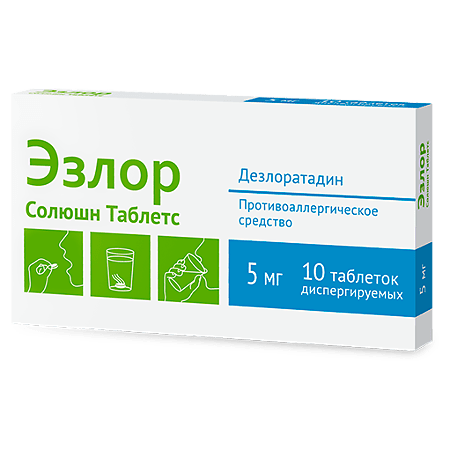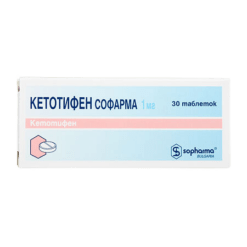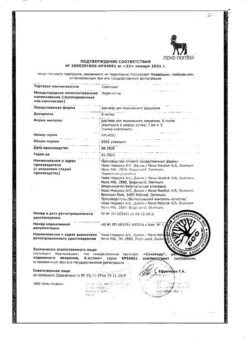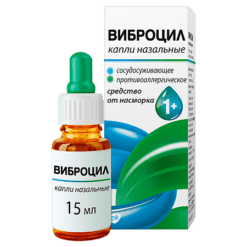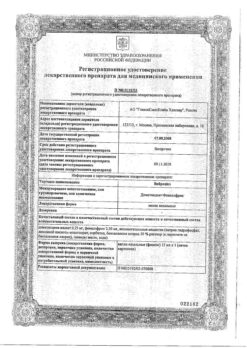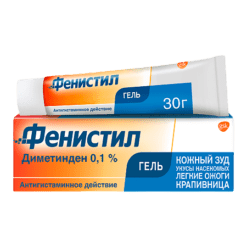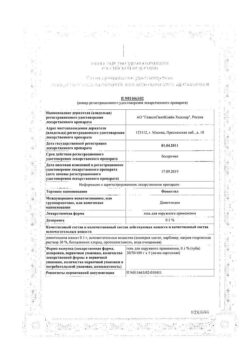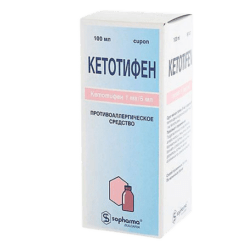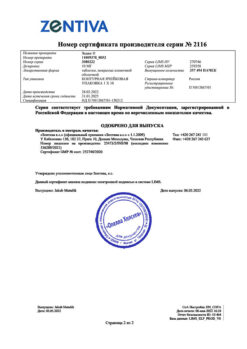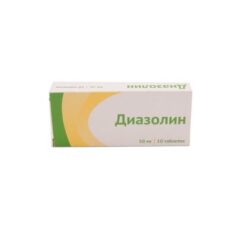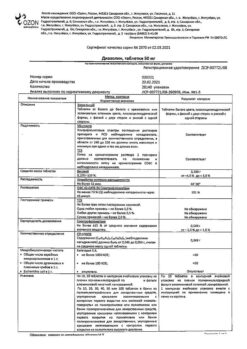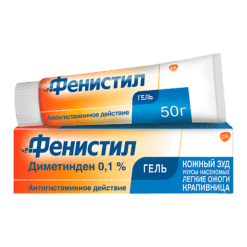No products in the cart.
Description Pharmacokinetics:
H1-histamine receptor blocker (long-acting). It is the primary active metabolite of loratadine. Inhibits cascade of allergic inflammatory reactions, including release of anti-inflammatory cytokines, including interleukins IL-4, IL-6, IL-8, IL-13, release of pro-inflammatory chemokines (RANTES), production of superoxide anions by activated polymorphonuclear neutrophils, eosinophil adhesion and chemotaxis, release of adhesion molecules such as P-selectin, IgE-mediated release of histamine, prostaglandin D2 and leukotriene C4.
Thereby it prevents development and facilitates the course of allergic reactions, has antipruritic and antiexudative effects, reduces capillary permeability and prevents development of tissue edema and smooth muscle spasm.
The drug has no effect on the central nervous system, it has practically no sedative effect (does not cause sleepiness) and does not affect the speed of psychomotor reactions. In clinical and pharmacological studies of desloratadine in the recommended therapeutic dose no prolongation of the QT interval on ECG was noted.
The action of the drug starts within 30 minutes after oral administration and lasts for 24 hours.
Absorption
After oral administration, desloratadine is well absorbed from the gastrointestinal tract, with detectable plasma concentrations of desloratadine reached within 30 minutes and a maximum concentration after approximately 3 hours.
Distribution
The binding of desloratadine to plasma proteins is 83-87%. When used in adults and adolescents for 14 days at a dose of 5 mg to 20 mg once daily there is no clinically significant cumulation of desloratadine. Concomitant intake of food or concomitant consumption of grapefruit juice has no effect on the distribution of desloratadine (when taken at a dose of 7.5 mg once daily). It does not penetrate through the blood-brain barrier.
Metabolism
It is subjected to intensive metabolism in the liver by hydroxylation to form 3-OH-desloratadine combined with glucuronide. It is not an inhibitor of CYP3A4 and CYP2D6 isoenzymes and is not a substrate or inhibitor of P-glycoprotein.
Elimation
Only a small portion of the ingested dose is excreted by the kidneys (< 2%) and through the intestine (< 7%). The elimination half-life is 20-30 hours (average – 27 hours).
.
Indications
Indications
– Allergic rhinitis (elimination or relief of sneezing, nasal congestion, nasal mucus, itching of the nose, itching of the palate, itching and redness of the eyes, watery eyes);
– urticaria (reduction or elimination of skin itching, rash).
Pharmacological effect
Pharmacological effect
H1-histamine receptor blocker (long-acting). It is the primary active metabolite of loratadine. Inhibits the cascade of allergic inflammation reactions, including the release of anti-inflammatory cytokines, including interleukins IL-4, IL-6, IL-8, IL-13, the release of proinflammatory chemokines (RANTES), the production of superoxide anions by activated polymorphonuclear neutrophils, the adhesion and chemotaxis of eosinophils, the release of adhesion molecules such as P-selectin, IgE-mediated release of histamine, prostaglandin D2 and leukotriene C4.
Thus, it prevents the development and facilitates the course of allergic reactions, has antipruritic and antiexudative effects, reduces capillary permeability, and prevents the development of tissue edema and smooth muscle spasm.
The drug has no effect on the central nervous system, has virtually no sedative effect (does not cause drowsiness) and does not affect the speed of psychomotor reactions. In clinical and pharmacological studies of the use of desloratadine at the recommended therapeutic dose, there was no prolongation of the QT interval on the ECG.
The effect of the drug begins within 30 minutes after ingestion and continues for 24 hours.
Pharmacokinetics:
Suction
After taking the drug orally, desloratadine is well absorbed from the gastrointestinal tract, with detectable concentrations of desloratadine in the blood plasma achieved within 30 minutes, and the maximum concentration after approximately 3 hours.
Distribution
The binding of desloratadine to plasma proteins is 83-87%. When used in adults and adolescents for 14 days at a dose of 5 mg to 20 mg 1 time / day. There is no clinically significant accumulation of desloratadine. Simultaneous food intake or simultaneous consumption of grapefruit juice does not affect the distribution of desloratadine (when taken at a dose of 7.5 mg 1 time / day). Does not penetrate the blood-brain barrier.
Metabolism
It is extensively metabolized in the liver by hydroxylation to form 3-OH-desloratadine combined with a glucuronide. It is not an inhibitor of CYP3A4 and CYP2D6 isoenzymes and is not a substrate or inhibitor of P-glycoprotein.
Removal
Only a small portion of the oral dose is excreted by the kidneys (<2%) and intestines (<7%). The half-life is 20-30 hours (on average 27 hours).
Special instructions
Special instructions
There have been no studies of the effectiveness of desloratadine in rhinitis of infectious etiology.
Impact on the ability to drive vehicles. Wed and fur.:
At the recommended dose, the drug does not affect the ability to drive vehicles or operate machinery.
The potential for side effects such as dizziness and drowsiness should be taken into account. If the described adverse events occur, you should refrain from performing these activities.
Active ingredient
Active ingredient
Desloratadine
Composition
Composition
Active substance:
desloratadine – 5.0 mg.
Excipients:
calcium hydrogen phosphate dihydrate – 170.0 mg;
microcrystalline cellulose – 50.0 mg;
sodium carboxymethyl starch – 6.0 mg;
aspartame – 5.0 mg;
magnesium stearate – 2.4 mg;
colloidal silicon dioxide – 1.6 mg.
Pregnancy
Pregnancy
The use of the drug during pregnancy is contraindicated due to the lack of clinical data on the safety of its use during pregnancy.
Desloratadine is excreted in breast milk, so use of the drug during breastfeeding is contraindicated.
Contraindications
Contraindications
– Hypersensitivity to desloratadine, other components of the drug or to loratadine,
– pregnancy and breastfeeding period,
– children under 1 year of age,
– phenylketonuria.
With caution:
Severe renal failure.
Side Effects
Side Effects
The incidence of side effects is classified according to the recommendations of the World Health Organization: very often – at least 10%; often – no less than 1%, but less than 10%; infrequently – not less than 0.1%, but less than 1%; rarely – not less than 0.01%, but less than 0.1%; very rarely – less than 0.01%; frequency is unknown (it is not possible to determine the frequency based on available data).
From the immune system: very rarely – itching, rash, including urticaria, angioedema, dyspnea, anaphylaxis.
From the central nervous system: often – headache, insomnia (in children under 2 years of age); very rarely – dizziness, drowsiness, insomnia, psychomotor hyperactivity, convulsions, hallucinations.
From the cardiovascular system: very rarely – tachycardia, palpitations, prolongation of the QT interval.
From the gastrointestinal tract: often – dry mouth, diarrhea (in children under 2 years of age); very rarely – nausea, vomiting, dyspepsia, diarrhea, abdominal pain, increased activity of liver enzymes, increased bilirubin concentration, hepatitis.
From the musculoskeletal system and connective tissue: very rarely – myalgia.
From the skin and subcutaneous tissues: very rarely – photosensitivity.
Other: often – increased fatigue, fever (in children under 2 years of age); frequency unknown – asthenia.
Post-registration period
Children: frequency unknown – QT interval prolongation, arrhythmia, bradycardia.
If any of the side effects indicated in the instructions get worse, or you notice any other side effects not listed in the instructions, tell your doctor.
Interaction
Interaction
Interactions with other drugs were not detected in studies with azithromycin, ketoconazole, erythromycin, fluoxetine and cimetidine. Simultaneous ingestion of food or consumption of grapefruit juice does not affect the effectiveness of the drug.
Desloratadine does not enhance the effects of alcohol on the central nervous system; however, cases of alcohol intolerance and alcohol intoxication have been reported during post-marketing use. Therefore, desloratadine is one
Overdose
Overdose
Symptoms: Taking a dose 5 times the recommended dose did not result in any symptoms. In clinical studies, daily use of desloratadine in adults and adolescents at a dose of up to 20 mg for 14 days was not accompanied by statistically or clinically significant changes in the cardiovascular system.
In a clinical and pharmacological study, the use of desloratadine at a dose of 45 mg per day (9 times higher than recommended) for 10 days did not cause prolongation of the QT interval and was not accompanied by serious side effects.
Treatment: in case of accidental ingestion of a large amount of the drug – gastric lavage, intake of activated charcoal; if necessary, symptomatic therapy. Desloratadine is not eliminated by hemodialysis; the effectiveness of peritoneal dialysis has not been established.
Storage conditions
Storage conditions
In a place protected from light at a temperature not exceeding 25 ° C.
Keep out of the reach of children.
Shelf life
Shelf life
3 years. Do not use after expiration date.
Manufacturer
Manufacturer
Ozon, Russia
Additional information
| Shelf life | 3 years. Do not use after the expiration date. |
|---|---|
| Conditions of storage | In the dark place at a temperature not exceeding 25 °С. Store out of the reach of children. |
| Manufacturer | Ozon, Russia |
| Medication form | dispersible tablets |
| Brand | Ozon |
Related products
Buy Ezlor Solution Tablets, 5 mg 10 pcs with delivery to USA, UK, Europe and over 120 other countries.

